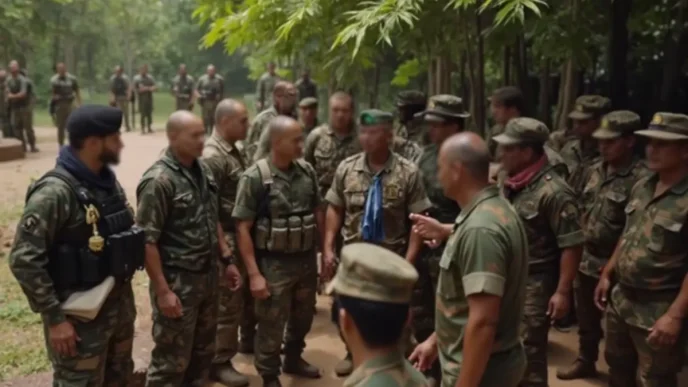A catastrophic 7.7 magnitude earthquake struck central Myanmar on March 28, 2025, leaving a trail of destruction centered near the historic city of Mandalay. With a death toll already surpassing 2,000 and injuries exceeding 3,000, experts warn that casualties could climb into the tens of thousands as rescue efforts continue amidst aftershocks and the complicating backdrop of an ongoing civil war. The disaster, attributed to the Sagaing Fault, has exposed the region’s vulnerable infrastructure and raised urgent questions about humanitarian aid delivery in a nation fractured by conflict.
Seismic Power and Immediate Impact
The earthquake’s epicenter, located near Mandalay, unleashed energy equivalent to hundreds of atomic bombs, according to geologist Jess Phoenix in an interview with CNN. Occurring at a shallow depth of just 10 kilometers, the quake’s “strike-slip” motion—similar to that of California’s San Andreas Fault—intensified ground shaking, causing widespread structural damage. Dr. Rebecca Bell of Imperial College London explained that this shallow origin amplified the destruction, particularly in densely populated areas with poorly enforced building codes.
Mandalay, a cultural and economic hub, bore the brunt of the disaster. Images of the damaged Mandalay Palace, an iconic symbol of Myanmar’s heritage, captured the scale of destruction as a Buddhist monk walked past during sunset on March 31. The tremor’s reach extended nearly 1,000 kilometers to Bangkok, where a building under construction collapsed due to the city’s soft soil amplifying the seismic waves, as noted by Dr. Roberto Gentile of University College London.
Dr. Ian Watkinson of Royal Holloway, University of London, highlighted the vulnerability of cities like Mandalay, built on the floodplains of the Ayeyarwaddy River with rapid, often substandard high-rise construction. He suggested the quake likely propagated along the Sagaing Fault for up to 200 kilometers, a tectonic structure accommodating the northward motion of the Indian plate. This geological context, combined with Myanmar’s history of seismic activity, underscores the disaster’s deadly potential.
Casualty Forecasts and Aftershock Risks
Early estimates from the US Geological Survey’s PAGER system forecast a staggering 10,000 to 100,000 fatalities, a grim prediction echoed by Professor Ian Main of the University of Edinburgh. “The combination of dense population centers and vulnerable buildings creates a perfect storm for high casualties” he told the Science Media Centre in the UK. As of April 1, the confirmed death toll stood at over 2,000, with numbers expected to rise as rescue teams— hampered by damaged infrastructure and ongoing conflict—reach remote areas.
Aftershocks, which experts warn could persist for months, pose an additional threat. Professor Bill McGuire of University College London described Myanmar as “one of the most seismically active countries in the world” predicting a significant increase in casualties as the full extent of the damage emerges. Hospitals in affected areas are overwhelmed, with reports of patients in Mandalay being moved to car parks out of fear that weakened structures could collapse during aftershocks.
Humanitarian Crisis Amidst Civil War
The earthquake’s timing could not be worse for Myanmar, a nation already reeling from a civil war sparked by a military coup in 2021. The conflict has devastated the economy, disrupted communication networks, and left much of the population in dire need even before this natural disaster. Professor Ilan Kelman, also of University College London, emphasized the political barriers to aid delivery, pointing to the military junta’s history of restricting international assistance. “Effective relief requires coordination and trust, both of which are in short supply given the current conflict” he warned.
The ongoing war has compounded logistical challenges. Roads and bridges, critical for transporting aid, have been damaged by both the earthquake and years of fighting. Communication blackouts in conflict zones make it difficult to assess the full scale of the disaster, leaving the international community struggling to respond. Myanmar’s declaration of a week of mourning reflects the national scale of the tragedy, but it remains unclear how the government—or the various resistance groups controlling parts of the country—will facilitate recovery.
International Response and Regional Solidarity
Despite the challenges, neighboring countries have mobilized to assist. China has already rescued six individuals in quake-hit areas, while Vietnam has deployed teams to survey and locate victims. Indonesia and the Philippines are sending rescue and medical personnel, with Filipino teams specifically searching for missing nationals in Mandalay. Thailand, meanwhile, grapples with its own aftershock-related evacuations in Bangkok, where safety concerns over high-rise buildings have intensified public anxiety.
These efforts, while commendable, face significant hurdles. The sheer scale of destruction, combined with Myanmar’s political instability, means that international aid may struggle to reach those most in need. Reports of patients camping outside hospitals and survivors scavenging through rubble highlight the desperation on the ground. The cost of rebuilding, estimated in preliminary assessments to run into billions of Myanmar Kyat (exact USD conversion pending further data), adds another layer of complexity to an already dire situation.
Geological Context and Future Preparedness
Myanmar’s location at the collision zone of the Indian and Eurasian tectonic plates makes it a hotspot for seismic activity. Dr. Brian Baptie of the British Geological Survey noted the country’s history of significant earthquakes, warning that densely populated regions remain at high risk without robust infrastructure. The Sagaing Fault, a major tectonic feature, has long been a source of concern for geologists, with this latest event confirming fears of its destructive potential.
Experts are now calling for urgent reforms in building codes and urban planning. Professor Kelman stressed the importance of enforcing regulations to ensure structures can withstand future quakes, a challenge in a country where resources are stretched thin by conflict. The rapid urbanization of cities like Mandalay, often without adequate oversight, has left millions exposed to seismic risks. Dr. Watkinson pointed to the floodplains of the Ayeyarwaddy River as particularly vulnerable, urging a rethinking of construction practices in such areas.
A Nation at a Crossroads
As rescue operations intensify and the death toll mounts, Myanmar faces a dual crisis of natural disaster and political upheaval. The earthquake has not only shattered buildings but also exposed the fragility of a nation divided by war. International aid, while critical, must navigate a labyrinth of logistical and political obstacles to reach survivors. Meanwhile, the specter of aftershocks looms large, threatening to undo what little stability remains.
For the people of Mandalay and beyond, the road to recovery will be long and fraught with uncertainty. As one survivor in Mandalay told a local reporter, “We have lost everything, but we must keep going for our families” The resilience of Myanmar’s communities will be tested in the weeks and months ahead, but whether the fractured nation can unite in the face of such tragedy remains an open question.














